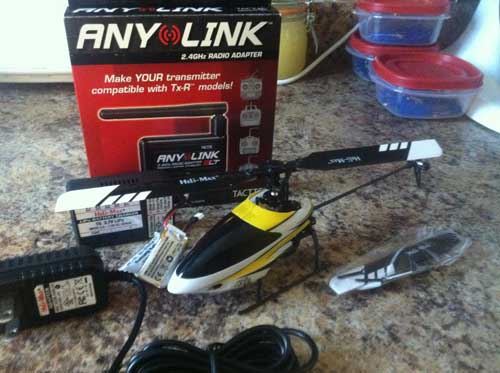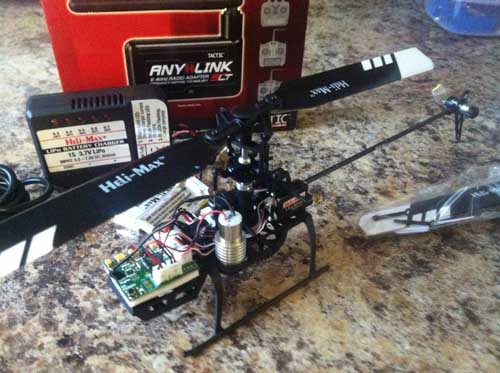
Helimax Axe 100 CP Review
Written by Dan Reed
Micros…for some of us, it’s a love-hate relationship. There is, however, no question that the recent influx of micro RC helicopters on the market has lead to an increase in new fliers to our hobby. Up until recently, we really did not have a wide variety of radio brands that could be used to enjoy these capable little RC helicopters. I would like to take a few minutes to talk about one such micro heli…the Helimax Axe 100 CP.
First, we need to make the distinction between the Fixed Pitch or FP version and the Collective Pitch or CP version. These two helis look very similar. The obvious difference is the performance that CP offers, as it allows for separation of the throttle curves and pitch curves. This is what enables the heli to operate in a much larger flight envelope, evidenced primarily by its ability to fly inverted.
Let’s take a look at some specs…
You can get the Axe 100 CP in a complete RTF package with a TX-610 radio. This radio features 2.4 Ghz , 5-point pitch curve, programmable throttle curves, exponential, digital trims and adjustable gyro sensitivity.
The model I reviewed was the TX-ready version essentially a bind-and-fly. We did a review on the Any Link system that is needed to get any radio with trainer port to communicate with this version of the Axe 100 CP. Included with the heli are two 1S 200 mAh Li-Po batteries, a wall charger, screwdriver, extra set of blades, extra tail rotor, and linkage set.
The Axe 100 CP uses a TAGS Triple Axis Gyro from Helimax. It’s essentially a flybarless heli… All the usual components are included on the heli such as a brushed motor, ESC, digital rotary drive servos, and receiver. Stock main blades for the Axe 100 CP measure out at 109 mm. This little heli weighs in at 1.6 oz ready-to-fly with a rotor diameter of 9.5 inches (241 mm) and a length of 9.5″ (241 mm).
First Impressions
It seems to me that I see more and more micros showing up at the field in the summer or indoor flying at a local gym. I even see people use the box that their favorite micro came in for transport, which makes it very convenient. I can not help but wonder if Helimax was somehow aware of this fact…the reason I mention this is because at approximately 9x14x3 inches, this box makes for easy handling during transport. All parts sit nicely in formed plastic and there is also a formed top piece that holds everything place. The manual sits at the bottom and everything else is there…all you need is to plug in a radio and the AnyLink and your on the deck with your new micro.
Lets get to the good stuff! The Axe 100 CP itself is a nice looking heli. The canopy is yellow and white with some black highlights. Unlike some other micros that I have flown, this canopy has two mounting points at the rear of the canopy and the front slides onto the landing gear. Also the canopy seems to follow the trend we’re seeing today style-wise, as it curves around the back of the airframe behind the main shaft. This accomplishes two goals: first, it seems that this allows for the canopy to slide further onto the mounting posts and second, it gives the heli a modern and sleek look.
The first notable difference between the Axe and other micros was the fact that this heli does not use linear servos. It actually has pre-installed Helimax 1.9g rotary-cased servos. Also, the main shaft is a hollow metal alloy shaft. Furthermore, it was nice to see a modular design in that the landing gear and the tail boom attached directly to the main frame.
The tail boom has an octagonally-shaped cross-section, which gives it a bit more rigidity. The tail rotor is also much stiffer than you’ll find on most other micros. Aside from the main shaft, feathering shaft, servo-to-swash links, and pinion, most of the other components are plastic, as you would expect. I was unable to find any documentation, but the modulus on the main gear is larger than you see on other micros, as well.
Getting the Axe 100 CP ready to fly was a breeze. For more information you can check out my AnyLink review. I did not get too technical about setup…basically, I just programmed the radio and eyeballed the swash level and I was ready to go. I will mention that the servo links are adjustable if you find your swash needs some fine-tuning.

Flight Performance
I am hyper-critical of micro helis for two reasons… Firstly, I am not a fan of the continuous tweaking method for getting a heli to fly well. Secondly, I think that buying a micro and then needing to purchase a list of aftermarket products to get it to handle well is just silly. It seems counter-productive to the reasons why we go out and spend a few hundred dollars on a micro, doesn’t it? If you have to throw another couple hundred bucks at it to make it work right, then whats the point?
The manual has suggested starting points for programming various flight conditions. Right off the bat the “stock” settings really did a fine job for a first flight with one exception: the tail. The manual suggests you set the tail to zero exponential and rates up to 140 and while this did work, it left the tail feeling a bit sluggish. I ended up adding about 20 positive exponential to get the tail to feel responsive enough for my liking.
Since we are talking about the tail there are a few things we should discuss. It’s worth mentioning that the stock length is longer than you’ll find on the other comparable micros. You might remember there was a common mod floating around that added an extra 2.5cm to the stock length of one of those other popular micros. The Helimax Axe 100 is designed right out of the box that way, so tail authority is not really an issue until you start grabbing gobs of collective.
I put this heli through some gloriously noobish collective hell…non-stop pitch pumps, inverted punch outs, sloppy flips and rolls and no matter how much poor collective management I threw at the Axe 100 CP, I could not get the tail to blow out completely. It may have put up a struggle every now and again, but it quickly recovered. As a guy that is prejudice about micros, I am happy to say that this was very pleasing. It was my main complaint on all the other various micros that I’ve owned in the past and luckily Helimax passed this little test of mine…
From the start, the Axe 100 CP had a noticeable head bobble that seemed to me to be a head speed issue. I tried various head speed settings ranging from a flat 80% to 100% throttle curves and was able to get the bobble tuned out the best at around 95%. Anything above 95% did not make a difference and anything below started to make the bobble worse. I suspect there is more to this and I’ll get into a little further down in the battery and charger section.
Crashworthiness
Another reason micro helis are popular is because they are durable. The Axe 100 CP is no exception. Where you’re flying is obviously the biggest factor in how long this heli will last. Over concrete or in the gym, you should expect more damage in a crash, but over grass or other softer surfaces it should be able to handle quite a beating. Also, I can not stress enough how important throttle hold is! Learn it, use it, love it.
I did have a few hard impacts into tables and walls with no damage to the Axe. It seemed to me that with other micros, if you didn’t mod the anti-rotation bracket that captures the swash-to-head links, it was typical to find that your links would eventually loosen. The Axe 100 CP uses a similar method of capturing those two links; however, the difference is they do not simply sit in the anti-rotation bracket fork, but rather the ends of those forks are turned in to allow the link to snap into place. This allows them to move up and down freely, but prevents them from loosening during a crash.
Batteries and Charger
There is no nice way to put this…the stock batteries that come with the Axe 100 CP are not the best quality. I did just as the manual suggested and set my flight timer at 4 minutes and I never exceeded this time. Of the two stock batteries, one went dead at 15 cycles and the other would only allow for about a two-minute flight after only 20 cycles. I mentioned a head bobble issue above and, without having any other batteries to try out, it seems to me that these batteries played a role in my inability to tune that bobble out completely.
Although they work, most stock chargers that come with micro helis leave something to be desired and the Helimax charger is no exception. You are able to select your charging rate from 0.3 to 0.7 amps, which leaves you with about a 30-minute wait time for one battery to be charged. I would definitely suggest looking into after-market charging solutions if you’re going to take this seriously…
Conclusion
Pros:
– You don’t need a JR/Spekrum radio.
– Very durable.
– The Helimax line is carried by some of the largest online shops out there and parts availability is not an issue. Also, cost of parts replacements falls right into line with similar micros.
– It has great tail authority even when challenged with poor collective management.
– Rotary digital servos instead of linear servos.
– Fully 3D capable.
– Longer, stiffer tail boom and stiffer tail rotor.
– Aftermarket parts availability is increasing.
Cons:
– Well, it’s a micro, but we knew that going into it. 🙂
– Stock batteries aren’t that great, so you should definitely look at replacing them as soon as possible.
– The main blades are very flexible and you might want to consider an aftermarket upgrade there too.
– Brushed power system instead of brushless.
– You will either need to buy the RTF with the radio or the Any Link. This is a con for those that are used to the DSM micros, but a Pro for those of us who are not.
– Motor driven tail. It’s kind of early yet to tell if we are going to see issues similar to what we saw with other micros that had the same design.
Simply put, Helimax put a lot of thought into this design. They picked up where other popular micros left off and even kicked it up a notch. This heli is a wonderful pick for a new flier and will even keep advance pilots entertained. I do, however, think that more advanced pilots will quickly be looking for aftermarket upgrades to enhance its 3D potential.
I would like to thank the folks over at Hobbico for allowing us to review this Helimax Axe 100 CP. This review was a challenge for me, mainly because of my past experiences with micros. Listeners of RC Heli Nation are well aware of my often expressed opinions when it comes to small helis in general. I was pleasantly surprised how quickly this heli turned those opinions around and I look forward to the future of micro heli’s in our great hobby!
– Dan
